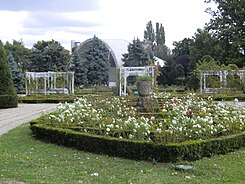Rose Park (Timișoara)
| Parcul Rozelor Grădina Rozelor |
|
|---|---|
| Park in Timisoara | |

|
|
| Rose park | |
| Basic data | |
| place | Timișoara |
| District | Cetate |
| Created | 1891 |
The Parcul Rozelor ( Rose Park ), also Grădina Rozelor ( Rose Garden ), is a park in the first district Cetate the western Romanian city of Timisoara . It was laid out in 1891 on the northern side of the Bega and is one of the city's landmarks . He owes it the nickname City of Roses .
history
By 1891 began razing the fortifications even that could fortress foothills of a new civilian use are supplied. For this purpose, the city entrusted the landscape architects and rose growers Wilhelm Mühle and Wenceslas Franz Niemitz with the planning and execution of the royal rose garden based on the example of the English landscape gardens and the French baroque gardens . The Franz-Joseph-Park was created , which was inaugurated on June 19, 1891 on the occasion of the universal exhibition for industry and agriculture , which lasted until September 30 of the same year. For the rose garden, the city administration had provided a nine-hectare area between today's Parcul Justiției in the southwest and the exhibition area in the northeast, the elongated area was bordered by the railway line to Caransebeş on the one hand and by the Bega on the other. Emperor Franz Joseph I visited the park named after him on September 16, 1891 and was impressed by the beauty of the flower arrangements.
During the First World War , the Franz-Joseph-Park was almost completely destroyed and converted into a pasture for the horses of the German cavalry. After the war, the south-western half of the park was redesigned by the landscape gardener Árpád Mühle , Wilhelm Mühle's son, together with the architect Mihai Demetrovici and henceforth referred to as Parcul Rozelor or Grădina Rozelor . The northeastern part of Franz-Joseph-Park , however, was separated in the inter-war period by the construction of today's Bulevardul Michelangelo and was henceforth called Parcul Mihai Eminescu . The rose park, on the other hand, developed under Árpád Mühle with over 1400 rose species from Europe , America and Asia in the interwar period to become the largest rosarium in Southeast Europe. At that time, two state congresses for horticulture were held on the site.
In 1934 the complex was formally inaugurated as a park. The establishment was thanks to the mostly female sponsors who financed the purchase of various types of roses abroad. A summer theater that still exists today was also set up in the park . In 1942 the park was temporarily renamed Parcul Regina Maria before it was destroyed in the course of the Second World War. In 1955 the summer garden was set up in one half of the park . The Parcul Rozelor was not restored until 1965 . Other alternative names were Rosarium Regina Maria , Parcul Trandafirilor and Parcul de cultură și odihnă Ștefan Plăvăț .
In 2011 the park was refreshed with 9,000 rose bushes, 450 trees and bushes, 11,000 square meters of lawn, 77 benches, twelve pergolas, 35 wastebasket, 70 photovoltaic lanterns, a computer-controlled sprinkler system , Roman ceramic vases and a newly paved avenue . The cost of this was 5.6 million lei, most of which came from EU funding.
Wilhelm Mühle, who did a lot for the creation of the park, was posthumously made an honorary citizen of the city of Timisoara on August 2nd, 2013 . The unveiling of his bust in the rose garden took place on the same day.
Today the rose park is characterized by long rhombus-shaped avenues, white wooden benches, rose trellises , round beds with roses of all kinds and promenade paths . With the summer theater, the Rosenpark is an important cultural location in the city in summer. The international folklore festival Festival of Hearts ( Romanian Festivalul Inimilor ) takes place here every year.
The Opera and Operetta Festival was launched in 2005 and has been held annually in the second half of August since then. The festival offers the public free performances by the Timisoara State Opera . In recent years, operas and operettas such as The Barber of Seville by Gioacchino Rossini , Carmen by Georges Bizet or the play for children Hansel and Gretel by Engelbert Humperdinck have been performed on the stage of the summer theater . Since then, the opera and operetta festival has taken place annually on the last weekend in August and the first weekend in September in the Rosenpark.
literature
- Andreea Oance: Timisoara - City of Gardens
- The rose park as a trademark , Banater Post, February 27, 2008
Web links
- Pictures , Parcul Rozelor, Timișoara Romania
- banaterra.eu , Parcul Rozelor din Timișoara , in Romanian
- primariatm.ro , Parcurile orașului Timișoara în decursul anilor , in Romanian
- rumaenien-info.at , Timișoara - Little Vienna
- welcometoromania.ro , Parcul Rozelor , in Romanian
- Balthasar Waitz : New hope blooms in the rose garden . Banat Newspaper, March 29, 2011
Individual evidence
- ↑ Parcul Rozelor din Timişoara . ( Memento of December 17, 2014 in the Internet Archive ) banaterra.eu; Retrieved November 3, 2014
- ↑ a b Queen Maria Rosary to get back royal charm . ( Page no longer available , search in web archives ) iasiinvest.ro, September 12, 2008 (English)
- ↑ primariatm.ro , Timișoara City Hall
- ↑ Press review 17. – 23. September 2011. Consulate of the Federal Republic of Germany
- ↑ Clara-Liselotte Basica: Bust in the Timisoara rose garden unveiled . ( Memento from September 23, 2015 in the Internet Archive ) banater-schwaben.org
- ↑ adz.ro , opera and operetta festival in the Rosenpark
Coordinates: 45 ° 45 ′ 0 ″ N , 21 ° 13 ′ 52 ″ E

